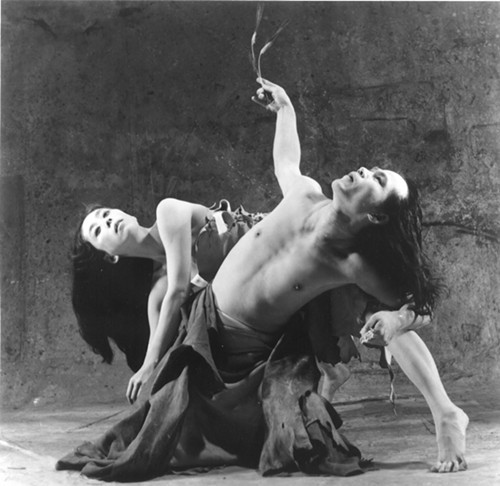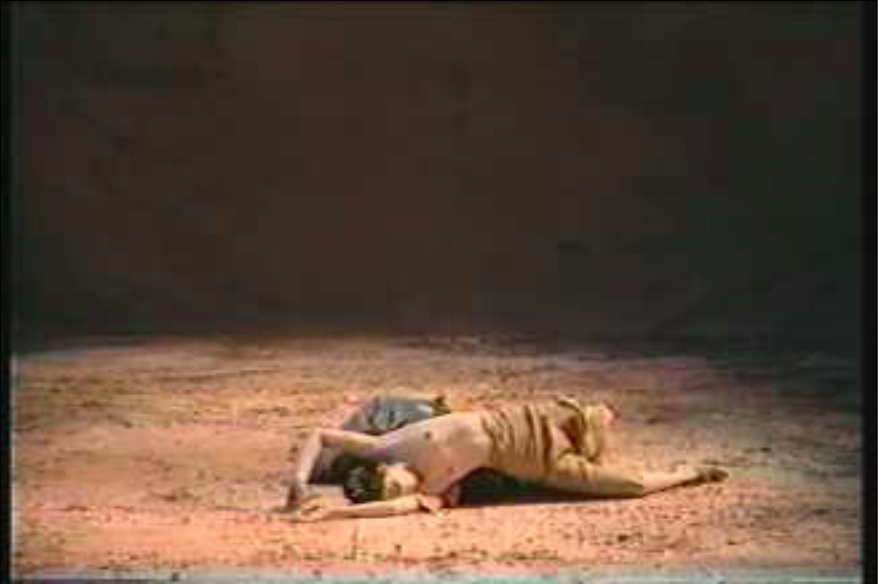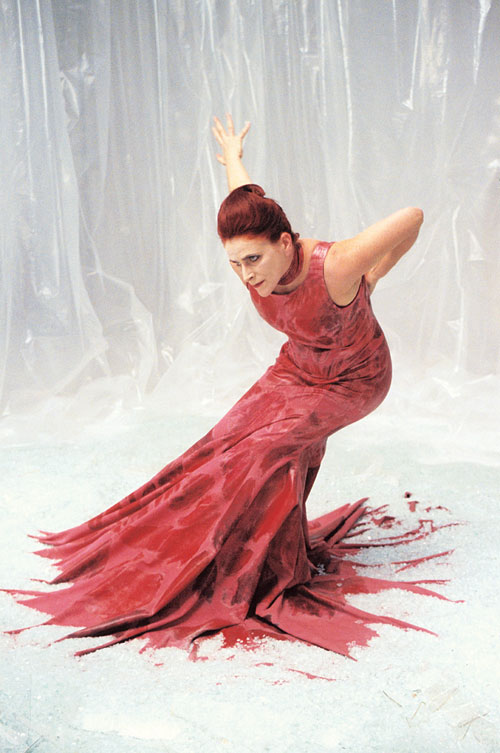Eiko and Koma, My Parents
This piece was created by their son, Shin Otake, serving as a documentary about his parents’ upbringing and forming of relationship in post-war Japan. That period was a time of political strife and disorder. A prime featured piece in the film was “Land”.
“Land” explored the interaction between the human body and nature by merging themselves into the environment through their washed and faded costume that mimicked sand. They depicted themselves as mountains in a desert.
Movement was very slow and careful, to create the illusion of stillness. They spread across the floor and slithered, all with gradual movements. In relation to the box, they were moving freely but at the same time it was very controlled in the space and slow, which shows the rootedness of a mountain.The “box” is very spacious and the lighting, this gives a sense of depth like the vast sky.
They even used sound to emphasise the piece. The sound of a drum was used to highlight some points, for example heartbeat of the mountain and the birth of a new mountain.
Motion Control
This piece explored the synergy between the camera and performer. It challenged how the relationship between the Motion Control camera and the dancer, camera and sound, camera and space can be pushed further.
The movement of dancer was very emotional and expressive. In the small “box”, a sense of entrapment seemed to be created with her movements that “filled” the box entirely. In the spacious white box, her movements from her upper body were big. Her big movements made the box seem smaller than it is, with her energy being projected widely. This contrasted with lower body, seemingly showing constrained movement due to the dress rooted to the ground.
Sound was very significant in this piece as well, the usage of foley was apparent. Electro-opera was used for dramatising the dance piece. Sound effects were linked very well with the movements to emphasise them, for example the sound of a CD scratch when the dancer moves her leg. Another example would be the sound of the red dress squeaking as she dances.




Great job Gladys!I agree with your point on foley noises in the motion control performance video. Sound was a product of her movement and it contributed to the visuals.
Yes, Gladys, I agree, very well researched and written. Question: how would you contrast these two works given one uses technology (Motion Control) and the other, while not using technology, is nevertheless a response to the technological upheaval during World War II. Both are very expressive, but using different means: nature vs electronics.
Statements of Meaning:
Gladys, your writing here is well articulated and lush as it describes your kinaesthetic experience of the video:
“They spread across the floor and slithered, all with gradual movements. In relation to the box, they were moving freely but at the same time it was very controlled in the space and slow, which shows the rootedness of a mountain.”
Yes, I love this “rootedness” word!
Gladys, here you are noting a relationship between sound and movement, and the viewer’s experience:
“They even used sound to emphasize the piece. The sound of a drum was used to highlight some points, for example heartbeat of the mountain and the birth of a new mountain.”
This resonates the word flesh for me. How might you integrate this idea into your costume/movement? Here is a video that plays with ways of showing how sound affects movement and the other way around: https://www.youtube.com/watch?v=vGmctjL9MeM
Gladys, I agree with this statement here:
“This piece explored the synergy between the camera and performer. It challenged how the relationship between the Motion Control camera and the dancer, camera and sound, camera and space can be pushed further.”
What you are describing is actually another genre of art called Screendance not unlike what we are experimenting with in the 3rd space. Here are a few Screendance videos that might interest you. They play with angles and this “synergy” you write about.
https://www.youtube.com/watch?v=Jg9UaErICGM&list=PLOwNfv3y-gyjz0MJRiiYohqh3ehdLWUJH&index=29
Questions for the Artist:
Gladys, how may different ways can you, through gesture, animate “a sense of entrapment”?